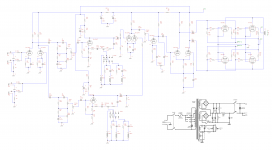...
Have you gone over the power rail bypass caps. A dodgy joint at either end of a single bypass cap could also cause that POC POC POC from the "motor boating" form of oscillation via feedback on the power rail.
Wow, thank for the tips. I will try your solution. Someone also suggested me that the issue might be motor boating. I change the 12AU7 stage to another cap, and the POC POC improved a lot. However, it keeps coming from time to time
P.S. Bothering with this cause I like your design, something I might build for myself "one day".
The difficult part was to find/make the toroïdale. Those are hand made, and I am afraid that this could be another source for the issue. I don't have a machine to build those kind of transformers.
You can find how to make those here
Bass preamplifier in the Ampeg SVT tradition
The output impedance from the 12AU7 cathodes is going to be really low, approaching 1/gm, say some thing like 100 Ohms, so try a 220 Ohm series "build out" resistor in series with the feed to C14, C16. Not 100% sure of that 100 Ohms output impedance "butt pluck / err. educated estimate from insufficient data" - so try resistors up to not more than 1K5. If that doesn't fix, higher values wont either.
I put a 100 Ohm resistor between the C14/C16 and the Cathode and it fix the issue 🙂
Sometimes the POC POC POC comes back
 , but not very frequent. I have no more ideas about what to do. In any case, I'll deliver the amplifier as is. There is something that triggers that noise, and I have no idea what could it be.
, but not very frequent. I have no more ideas about what to do. In any case, I'll deliver the amplifier as is. There is something that triggers that noise, and I have no idea what could it be.Thanks for the support
Yet another issue with Hiwatt replica
Hi
Here I come again asking for help for this Hiwatt replica that I build few months ago. There are the two threads that I received plenty of feedback to finalize the amp.
http://www.diyaudio.com/forums/instruments-and-amps/315831-clone-hybrid-hiwatt-ampeg-4.html
http://www.diyaudio.com/forums/instruments-and-amps/323230-issues-hybrid-hiwatt-ampeg.html
Few months ago I received the amplifier back because for some reason it starts to make a PUK PUK PUK noise. I added a video that shows the noise.
After looking for more info on the internet, I found out that it could be motor boating due to a defective decoupling cap on the power supply. I changed one of the two 100+100 uF cap. Maybe I need to change the second
I not sure if anyone can advise me what could I do.
Maybe changing the power supply itself, like adding another rectification stage.
Maybe someone has a layout of an original Hiwatt, it could be that I have a ground loop somewhere and it would be good to see how a real Hiwatt is cabled inside
Thank a lot for your help, this is the last step to complete this amplifier
Hi
Here I come again asking for help for this Hiwatt replica that I build few months ago. There are the two threads that I received plenty of feedback to finalize the amp.
http://www.diyaudio.com/forums/instruments-and-amps/315831-clone-hybrid-hiwatt-ampeg-4.html
http://www.diyaudio.com/forums/instruments-and-amps/323230-issues-hybrid-hiwatt-ampeg.html
Few months ago I received the amplifier back because for some reason it starts to make a PUK PUK PUK noise. I added a video that shows the noise.
After looking for more info on the internet, I found out that it could be motor boating due to a defective decoupling cap on the power supply. I changed one of the two 100+100 uF cap. Maybe I need to change the second
I not sure if anyone can advise me what could I do.
Maybe changing the power supply itself, like adding another rectification stage.
Maybe someone has a layout of an original Hiwatt, it could be that I have a ground loop somewhere and it would be good to see how a real Hiwatt is cabled inside
Thank a lot for your help, this is the last step to complete this amplifier
Attachments
Not sure if it is just the recording audio, but it sounds like something arcing(?).
Have you checked all your solder connections are good? No accidental shorts? Resistors close to the valves all correct values?
A really thorough visual inspection should be your first step.
Check the continuity of the output transformer. I've heard of motorboating being caused by open circuit OPTs before, as well as defective cap.
Being built a few months ago, I assume the parts (capacitors and valves) are from good stock? Have a good look at the capacitors - any leakage?
Does it happen at all settings (volume etc)?
If competent around high voltage, check the behaviour of the voltages when the amp is making the noise - is there an area of the circuit where the voltage is dipping? Try to narrow down the search area.
Have you checked all your solder connections are good? No accidental shorts? Resistors close to the valves all correct values?
A really thorough visual inspection should be your first step.
Check the continuity of the output transformer. I've heard of motorboating being caused by open circuit OPTs before, as well as defective cap.
Being built a few months ago, I assume the parts (capacitors and valves) are from good stock? Have a good look at the capacitors - any leakage?
Does it happen at all settings (volume etc)?
If competent around high voltage, check the behaviour of the voltages when the amp is making the noise - is there an area of the circuit where the voltage is dipping? Try to narrow down the search area.
 @blackwhaleamp - It's against the Forum Rules to start multiple threads on the same topic, as a result, your threads have been merged.
@blackwhaleamp - It's against the Forum Rules to start multiple threads on the same topic, as a result, your threads have been merged.Does it happen at all settings (volume etc)?
The issue happens after I play for a while. Then it keeps happening from time to time only when I play
Have a good look at the capacitors - any leakage?
Maybe there is a defective capacitor. I have to admit that once when I was manipulating the amplifier, I didn't discharge properly the capacitors and I received a very strong electric shock. Part of the skin from my finger was slightly burned. I have now a more serious procedure to discharge the capacitors before interacting with the amplifier.
Maybe at that moment one cap was damaged, so I'll recap the whole power supply just to be sure that everything is OK
I've heard of motorboating being caused by open circuit OPTs
Do you have any idea how to check if there is an open circuit OPTs?
Not sure if it is just the recording audio, but it sounds like something arcing(?).
I forgot to ask, what do you mean by arcing?
If it is happening after playing for some time, then it is quite possible that it is a component that goes into a fault condition when it heats up. Capacitors are a good bet - especially old ones - as well as solder joints - those can have cracks which are heat affected.
By OPT I meant output transformer. If you have a multimeter, you can do a continuity check of the output windings - look at the schematic to see where to test. Although a damaged transformer coil is more likely to present as a hard fault rather than intermittent.
The sound in the video is similar to when electricity jumps across a small gap - similar to a spark plug. But listening again, and considering your other information, this sounds more like instability of the circuit.
I would test the capacitors (carefully!) and solder joints / tube socket connections.
Large capacitors can hold enough energy to do more than just burn, so be careful and if you feel unsure, you might need to take it to a qualified technician.
By OPT I meant output transformer. If you have a multimeter, you can do a continuity check of the output windings - look at the schematic to see where to test. Although a damaged transformer coil is more likely to present as a hard fault rather than intermittent.
The sound in the video is similar to when electricity jumps across a small gap - similar to a spark plug. But listening again, and considering your other information, this sounds more like instability of the circuit.
I would test the capacitors (carefully!) and solder joints / tube socket connections.
Large capacitors can hold enough energy to do more than just burn, so be careful and if you feel unsure, you might need to take it to a qualified technician.
If it is happening after playing for some time, then it is quite possible that it is a component that goes into a fault condition when it heats up. Capacitors are a good bet - especially old ones - as well as solder joints - those can have cracks which are heat affected.
That's what I thought. All components are good, but maybe during the build and not proper discharge I damaged some components. I ordered a new set of caps
By OPT I meant output transformer. If you have a multimeter, you can do a continuity check of the output windings - look at the schematic to see where to test. Although a damaged transformer coil is more likely to present as a hard fault rather than intermittent.
Indeed, it's the Output Transformer. I agree with you, I don't think that the OPT is damaged
The sound in the video is similar to when electricity jumps across a small gap - similar to a spark plug. But listening again, and considering your other information, this sounds more like instability of the circuit.
I would test the capacitors (carefully!) and solder joints / tube socket connections.
Large capacitors can hold enough energy to do more than just burn, so be careful and if you feel unsure, you might need to take it to a qualified technician.
I'll check the solder joints. I'll also attach a picture so you can see how is done inside.
I know that touching a large cap could be letal. I consider myself lucky 🙁
I'll also try to find another technician who could help me. I designed and build this amplifier. I already did a dozen amps before (not a large experience, I know) But I never encounter this issue before
Thank again for the help. It encourage me to keep working on it 🙂
this sounds more like instability of the circuit.
I think it is the same. I completely change the power supply. I putted new caps, and also changed the structure. I also change some cables that go to the screen resistors. They were not very well done. Everything seems to be OK right now. However, the problem still there.
Again, after few minutes playing loud the PLAK noise comes back. It is not systematic nor periodic. It just comes and goes. Sometimes fast, sometimes slow.
Right now I completely discharge the caps before handling the amp. I measure carefully the voltage in order to be sure that they are properly out of energy
Do you think you could have a look to the pictures that I attached?
Hi Blackwhale
I didn't see any pictures attached to that post.
Have you tried swapping out tubes as well?
I didn't see any pictures attached to that post.
Have you tried swapping out tubes as well?
Hi Blackwhale
I didn't see any pictures attached to that post.
Have you tried swapping out tubes as well?
I noticed. I reduced the size of the images
Have you tried swapping out tubes as well?
I tried, both the pre-amp and power-amp tubes.
I also noticed that when I play, and I plug and unplug the instrument there is the same PLAK coming. I wondered if all the issues are mechanical. I removed all the input jacks, and installed only one switfcraft jack. But the noise still coming. Now, I was wondering if by adding a cap at the input would solve the problem. I still need to try this.
My last option is to change the PT and/or the OT.
Attachments
-
 IMG_20180812_183836.jpg210.4 KB · Views: 76
IMG_20180812_183836.jpg210.4 KB · Views: 76 -
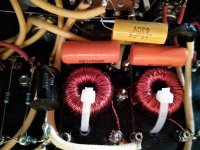 IMG_20180812_183812.jpg848.4 KB · Views: 71
IMG_20180812_183812.jpg848.4 KB · Views: 71 -
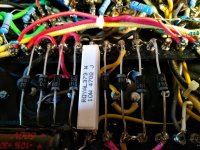 IMG_20180812_183733.jpg144.1 KB · Views: 69
IMG_20180812_183733.jpg144.1 KB · Views: 69 -
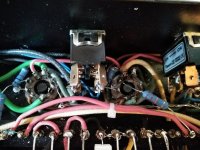 IMG_20180812_183727.jpg174.2 KB · Views: 61
IMG_20180812_183727.jpg174.2 KB · Views: 61 -
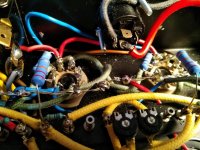 IMG_20180812_183718.jpg144.1 KB · Views: 71
IMG_20180812_183718.jpg144.1 KB · Views: 71 -
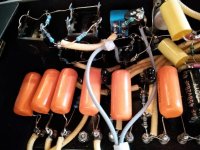 IMG_20180812_183602.jpg732.9 KB · Views: 125
IMG_20180812_183602.jpg732.9 KB · Views: 125 -
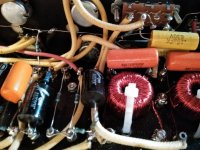 IMG_20180812_183555.jpg885.6 KB · Views: 123
IMG_20180812_183555.jpg885.6 KB · Views: 123 -
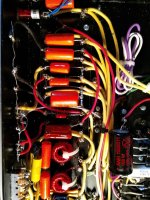 IMG_20180812_183545.jpg189.8 KB · Views: 131
IMG_20180812_183545.jpg189.8 KB · Views: 131 -
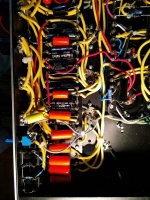 IMG_20180812_183531.jpg244.4 KB · Views: 129
IMG_20180812_183531.jpg244.4 KB · Views: 129 -
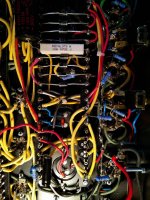 IMG_20180812_183526.jpg267.5 KB · Views: 135
IMG_20180812_183526.jpg267.5 KB · Views: 135
Not sure if it is just the recording audio, but it sounds like something arcing(?).
Hi,
So, I changed the ground layout following the recommendations from the document that I attached here. I couldn't follow to the rule because I have this tank caps. It looks that the issue is gone 🙂 I tried for a while and I haven't hear the arcing again.
However, in one specific configuration (Master around 7 and Volume around 8) there is an oscillation going on. I attached a video that shows the issue.
I added grid stoppers in every tube, but that does not removes the problem.
Any other suggestion that might help me to solve the problem?
Thanks a lot
Attachments
This might be a long-shot, but what about those inductors in the mid-control? Could they be picking up unwanted (mutual inductance) signal, from the output transformer for example? If you can shift their axis, it might be worth a try.
After months trying to fix this issue, I changed the OT and now the problem is gone. I still have the old one. How can I check that the transformer is damaged?
- Status
- Not open for further replies.
- Home
- Live Sound
- Instruments and Amps
- Hiwatt/Ampeg Clone
